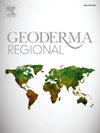基于电磁感应和地理空间技术的印度孙德尔本斯沿海地区作物性能评价土壤电导分类
IF 3.3
2区 农林科学
Q2 SOIL SCIENCE
引用次数: 0
摘要
印度孙德尔本斯沿海地区的可持续作物生产面临着季节性盐分积累的巨大挑战,尤其是在季风过后的季节。利用电磁感应(EM)技术测量土壤表观电导率(ECa)已成为快速评估土壤盐分的常用方法,可替代传统的成本和劳动力密集型实验室分析方法。本研究调查了 Bijoynagar(9.24 公顷)和 Sonagaon(9.69 公顷)两个试验点,利用 DualEM-1HS 评估了地表下 30 厘米、50 厘米、80 厘米和 160 厘米四个勘探深度 (DOE) 的导电率空间模式。利用普通克里金法(OK)对测得的导电率数据进行内插,以获得相应深度的连续导电率网格层,然后利用 K-means 聚类技术将这些网格层划分为六个土壤导电率单位(SCU)。在调查期间,Bijoynagar 地点的水稻休耕区种植了绿豆和其他一些蔬菜,其 ECa 值低于 Sonagaon 地点。在调查期间,Sonagaon 地块的主要部分处于休耕状态,零星种植了一些夏稻。每个 SCU 内 ECa 的变异系数在地表水平(最深 30 厘米)最为明显,这往往受到耕作和灌溉等农业措施的影响。实验室测量的土壤水悬浮物电导率(ECe)与群集数之间存在很强的相关性,斯皮尔曼等级相关系数(0.905)很高。作物根瘤层(表层至 50 厘米深)的导电率与绿豆秸秆产量、生物量产量和水稻谷物产量的相关系数最高。不同 SCU 中种植的夏稻和绿豆的集群数与产量之间的斯皮尔曼秩相关性也在 5 % 的水平上显著。用电磁感应方法评估表观土壤电导率的调查对于了解当地土壤盐度的波动及其对孙德尔本斯种植的两种主要作物的影响至关重要。改进后的电磁勘测涉及手持式全球定位系统和安卓应用程序 "GeoTracker",然后进行地理统计分析,并在本研究定制的开源地理信息系统平台上进行聚类,提供了一套强大的实践方法,能够快速、精确、有效地将土地划分为土壤电导率单位,以便在印度孙德尔本斯沿海盐碱地区进行特定地点的作物管理。本文章由计算机程序翻译,如有差异,请以英文原文为准。
Soil conductance classification for crop performance assessment using electromagnetic induction and geospatial techniques in coastal region of Indian Sundarbans
Sustainable crop production in the coastal zone of the Indian Sundarbans presents a significant challenge due to seasonal salinity build-up, particularly during the post-monsoon season. The measurement of apparent electrical conductivity (ECa) of soil using electromagnetic induction (EM) technique has emerged as a popular method for rapidly assessing soil salinity, serving as a proxy for traditional cost and labour-intensive laboratory analysis methods. This study investigated two test sites, Bijoynagar (9.24 ha) and Sonagaon (9.69 ha), to assess the spatial pattern of ECa at four depths of exploration (DOE)- 30 cm, 50 cm, 80 cm, and 160 cm below the surface using the DualEM-1HS. The measured ECa data were interpolated using Ordinary Kriging (OK) to get contiguous grid layers of ECa at respective depths which are subsequently classified into six Soil Conductance Units (SCUs) using K-means clustering technique. The Bijoynagar site, where mung beans and a few other vegetables were cultivated in the rice fallow during the survey recorded lower ECa than the Sonagaon site. The major part of the Sonagaon site was laid fallow during the survey, with patches of summer rice grown sporadically. The coefficient of variation of ECa within each SCU was most pronounced at the surface level (up to 30 cm depth), which was often influenced by agricultural practices such as tillage and irrigation. Strong correlations were observed between the laboratory-measured electrical conductivity of soil-water suspensions (ECe) and the cluster numbers, as evidenced by a high Spearman Rank Correlation coefficient (0.905). The ECa of the crop rhizospheric layer (surface to 50 cm depth) exhibited the highest correlation coefficients for mung bean stover yield, biomass yield, and rice grain yield. Spearman rank correlations between cluster numbers and the yield of summer rice and mung beans grown in different SCUs were also significant at the 5 % level. The investigation of the electromagnetic induction approach for assessing apparent soil conductivity has been crucial in understanding local fluctuation of soil salinity and its impact on performance of the two major crops grown in the Sundarbans. The improved EM survey involving hand-held GPS and Android application ‘GeoTracker’ followed by geostatistical analysis, and clustering in open-source GIS platform customized in this study offers a robust package of practices that enabled quick, precise and effective classification of land into Soil Conductance Units for site specific crop management in the coastal saline region of Indian Sundarbans.
求助全文
通过发布文献求助,成功后即可免费获取论文全文。
去求助
来源期刊

Geoderma Regional
Agricultural and Biological Sciences-Soil Science
CiteScore
6.10
自引率
7.30%
发文量
122
审稿时长
76 days
期刊介绍:
Global issues require studies and solutions on national and regional levels. Geoderma Regional focuses on studies that increase understanding and advance our scientific knowledge of soils in all regions of the world. The journal embraces every aspect of soil science and welcomes reviews of regional progress.
 求助内容:
求助内容: 应助结果提醒方式:
应助结果提醒方式:


